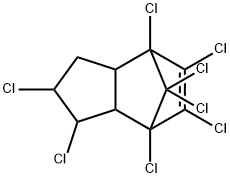Chlordane solution , analyticalstandard,inisooctane , 57-74-9
CAS NO.:57-74-9
Empirical Formula: C10H6Cl8
Molecular Weight: 409.78
MDL number: MFCD00072502
EINECS: 200-349-0
PRODUCT Properties
| Melting point: | 106-108℃ |
| Boiling point: | 492.46°C (rough estimate) |
| Density | 1.80 |
| vapor pressure | 10 at 25 °C (Sunshine, 1969)(x 10-6 mmHg) |
| refractive index | nD25 1.56-1.57 |
| Flash point: | 11 °C |
| storage temp. | 0-6°C |
| solubility | Miscible with acetone, cyclohexanone, deodorized kerosene, ethanol, 2-propanol,
trichloroethylene (Worthing and Hance, 1991) |
| Water Solubility | 0.1 mg l-1(25 °C) |
| form | Viscous amber liquid |
| Henry's Law Constant | 4.8 at 25 °C (gas stripping-GC, Warner et al., 1987)(x 10-5 atm?m3/mol) |
| Exposure limits | NIOSH REL: IDLH 0.5 mg/m3, IDLH 100 mg/m3; OSHA PEL: TWA
0.5 mg/m3; ACGIH TLV: TWA 0.5 mg/m3, STEL 2 mg/m3. |
| Stability: | Stable, but readily decomposed by moderately strong alkaline solutions. Corrodes iron and zinc and attacks some types of polymer. Incompatible with strong oxidizing agents. |
| CAS DataBase Reference | 57-74-9 |
| IARC | 2B (Vol. Sup 7, 53, 79) 2001 |
| EPA Substance Registry System | Chlordane (57-74-9) |
Description and Uses
Chlordane is a viscous, amber-coloured liquid. Technical-grade chlordane is a mixture of many structurally related compounds including trans-chlordane, cis-chlordane, chlordene, heptachlor, and trans-nonachlor. Chlordane was used as a broad-spectrum pesticide in the United States from 1948 to 1988. The uses included termite control in homes and pest control on agricultural crops such as maize and citrus, on home lawns, gardens, turf, and ornamental plants. Chlordane is a persistent organochlorine insecticide. It kills insects when ingested and on contact. Formulations include dusts, emulsifiable concentrates, granules, oil solutions, and wettable powder.
Chlordane is a persistent non-systemic contact and ingested insecticide with some fumigant action. It is used as a wood preservative, protective treatment for underground cables, and to reduce earthworm populations in lawns. It is used against Formicidae, Coleoptera, Noctuidae larva, Saltatoria, subterranean termites, and many other insect pests. It controls household insects, pests of man and domestic animals.
Safety
| Symbol(GHS) |    GHS06,GHS08,GHS09 |
| Signal word | Danger |
| Hazard statements | H301+H311-H351-H410 |
| Precautionary statements | P201-P202-P273-P280-P301+P310-P302+P352+P312 |
| Hazard Codes | Xn,N,Xi,F,T |
| Risk Statements | 21/22-40-50/53-36/37/38-11-39/23/24/25-23/24/25-67-65-38 |
| Safety Statements | 36/37-60-61-36-33-26-16-45-7-62-29-9 |
| RIDADR | 2995 |
| OEB | C |
| OEL | TWA: 0.5 mg/m3 [skin] |
| WGK Germany | 2 |
| RTECS | PB9800000 |
| HazardClass | 6.1(b) |
| PackingGroup | II |
| HS Code | 29038200 |
| Hazardous Substances Data | 57-74-9(Hazardous Substances Data) |
| Toxicity | LD50 i.p. in male rats: 343 mg/kg (Harbison) |
| IDLA | 100 mg/m3 |



